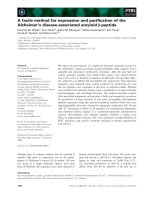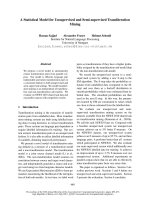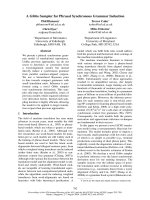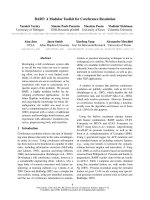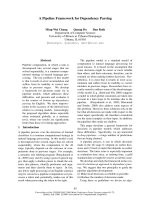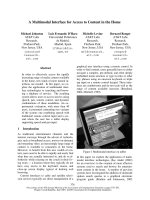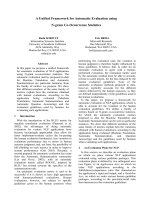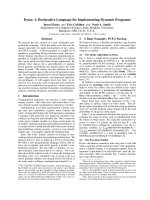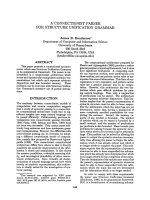Báo cáo khoa học: "A Robust System for Natural Spoken Dialogue " ppt
Bạn đang xem bản rút gọn của tài liệu. Xem và tải ngay bản đầy đủ của tài liệu tại đây (1.62 MB, 9 trang )
A Robust System for Natural Spoken Dialogue
James F. Allen, Bradford W. Miller, Eric K. Ringger, Teresa Sikorski
Dept. of Computer Science
University of Rochester
Rochester, NY 14627
{james, miller, ringger, sikorski)@cs.rochester.edu
http : //www. cs. rochester, edu/research/trains /
Abstract
This paper describes a system that leads us to
believe in the feasibility of constructing natural
spoken dialogue systems in task-oriented domains. It
specifically addresses the issue of robust interpre-
tation of speech in the presence of recognition
errors. Robustness is achieved by a combination of
statistical error post-correction, syntactically- and
semantically-driven robust parsing, and extensive
use of the dialogue context. We present an
evaluation of the system using time-to-completion
and the quality of the final solution that suggests
that most native speakers of English can use the
system successfully with virtually no training.
1. Introduction
While there has been much research on natural dialogue,
there have been few working systems because of the
difficulties in obtaining robust behavior. Given over
twenty years of research in this area, if we can't
construct a robust system even in a simple domain then
that bodes ill for progress in the field. In particular,
without some working systems, we are very limited in
how we can evaluate the worth of different models.
The prime goal of the work reported here was to
demonstrate that it is feasible to construct robust
spoken natural dialogue systems. We were not seeking
to develop new theories, but rather to develop tech-
niques to enable existing theories to be applied in
practice. We chose a domain and task that was as simple
as possible yet couldn't be solved without the
collaboration of the human and system. In addition,
there were three fundamental requirements:
• the system must run in near real-time;
• the user should need minimal training and not be
constrained in what can be said; and
• the dialogue should have a concrete result that can
be independently evaluated.
The second constraint means we must handle natural
dialogue, namely dialogue as people use it rather than a
constrained form of interaction determined by the
system (which is often called a dialogue). We can only
control the complexity of the dialogue by controlling
the complexity of the task. Increasing the task
complexity naturally increases the complexity of the
dialogue. This paper reports on the first stage of this
process, working with a highly simplified domain.
At the start of this experiment in November 1994, we
had no idea whether it was possible. While researchers
were reporting good accuracy (upwards of 95%) for
speech systems in simple question-answering tasks, our
domain was considerably different with a much more
spontaneous form of interaction.
We also knew that it would not be possible to directly
use general models of plan recognition to aid in speech
act interpretation (as in Alien & Perrault, 1980, Litman
& Allen 1987, Carberry 1990), as these models would
not lend themselves to real-time processing. Similarly,
it would not be feasible to use general planning models
for the system back-end and for planning its responses.
We could not, on the other hand, completely abandon the
ideas underlying the plan-based approach, as we knew of
no other theory that could provide an account for the
interactions. Our approach was to try to retain the
overall structure of plan-based systems, but to use
domain-specific reasoning techniques to provide real-time
performance.
Dialogue systems are notoriously hard to evaluate as
there
is no well-defined "correct answer". So we cannot
give end-to-end accuracy measures as is typically done to
measure the performance of speech recognition systems
and parsing systems. This is especially true when
evaluating dialogue robustness, which results from many
different sources: correcting speech recognition errors,
using semantic knowledge to interpret fragments, and
using dialogue strategies to keep the dialogue flowing
efficiently despite recognition and interpretation errors.
The approach we take is to use task-based evaluation.
We measure how well the system does at helping the
user solve the problem. The two most telling measures
are time-to-completion and the quality of the final
solution. In the evaluation described later in this paper,
we show that all our subjects were able to use TRAINS-
95 to solve problems with only minimal training. We
also evaluated the overall effectiveness of our robust
processing techniques by comparing spoken dialogues
with keyboard dialogues by the same subjects. Even
with a 30% word error rate (including insertion errors),
speech turned out to be considerably more efficient than
keyboard input in this domain.
2. The
Task and Example Session
The domain in TRAINS-95 is simple route planning.
The user is given a map on a screen showing cities,
62
connections and the locations of a set of trains (see
Figure 1), and a verbal specification of a set of
destination cities where trains are needed. The task is to
find the most efficient set of routes possible. The route
planner used by the system is deliberately weak so that
interaction is needed to find good plans. Specifically,
the planner cannot find routes longer than four hops
without an intermediate city, and when it can generate a
route, it randomly selects among the possibilities.
Typically, the examples in papers on dialogue systems
are carefully hand-constructed and designed to show off
specific system capabilities. Such examples, however,
give little feeling for how robust a system is. Much
more revealing is how a system responds to unplanned
interactions with naive users, and how it deals with the
interaction when things start to go wrong. Thus, we
won't present any examples in which everything went
smoothly. Rather, we present a dialogue that stresses
the system's capabilities, better illuminating what
works and what areas require further improvement.
The dialogue below was with a non-computer person
who had used the system a few times before. In the
transcripts, we show the input as it was produced by the
speech recognizer in ALL CAPS followed by what was
actually said. If the recognition was perfect we just
show the speech recognition output. The dialogue
contains a significant number of errors and has a 29.5%
word error rate. The system display is also shown at key
points 1. In this problem, the engines start at Detroit,
Montreal and Albany and the goal is to get trains to
Milwaukee, Lexington and Washington.
S: Ok. I think I'm ready to start.
U" OKAY LET'S SEE CONTAIN FROM DETROIT TO WASHINGTON
Okay. Let's take a train from Detroit to Washington.
S: What route would you like to get from Detroit to
Washington?
U: LET'S GO VIA TOLEDO AND PITTSBURGH
S:
(displays Figure 2)
The terminal at city Scranton is
delaying traffic due to localized heavy winds. The
terminal at city Baltimore is delaying traffic due to
localized heavy winds. An additional five hours will
be needed to travel through them due to decreased
visibility.
U: NOW LET'S TAKE THE TRAIN FROM DETROIT TO
WASHINGTON D S_X ANY
No. Let's take the train from Detroit to Washington
via Cincinnati.
S:
(displays Figure 3)
Okay.
U: OKAY IT THAT'S OKAY NOW
Okay that - that's okay now
S: Pardon Me?
U; UP OKAY NOW LET'S TAKE THE TRAIN FROM MONTREAL TO
LEXINGTON
Okay. Now let's take the train from Montreal to
Lexington.
' We apologize for the figures. The actual system uses color
displays. The best way to present examples is by video. A
quicktime movie can be found in
Figure 1: The initial scenario
Figure 2: The proposed route
Figure 3: The corrected route
63
S: I need help choosing a route from Montreal to
Lexington.
U- LET'S GO P_M TO TRY
Let's go via
Detroit
S:
(displays a route to Detroit but not on to Lexington)
Is this
OK?
U: YES NOW LET'S GO TO LEXINGTON
S: Yep.
U: OKAY NOW ADD STATE THE LAST TRAIN AND GO FROM
ALBANY TO O O'S
Okay Now let's take the last train and go
from
Albany to Milwaukee.
S: No. What city are you trying to have the engine at
Montreal arrive at, if I caught your drift. I don't
understand where we are sending the engine at
Albany to.
U: ME A JET ADD ALBANY NEEDS TO GO TO MILWAUKEE
The engine at Albany needs to go to Milwaukee.
S: Tell me a route to use to get from Albany to
Milwaukee, please.
U" I'D GO VIA BUFFALO
Uh
- Go via
Buffalo.
S:
(displays a route through Toronto and Buffalo) Yes.
U: GO B_X SYRACUSE AT BUFFALO
Go via Syracuse and Buffalo.
S:
(displays Figure 4) yeah.
U; THAT'S COULD I CAN
That's good. I'm done.
S:
Hey, itsthe
programming.
U:
I_NEED DONE
I'm done.
3. The System
The TRAINS-95 system is organized as shown in
Figure 5. At the top are the I/O facilities. The speech
recognition system is the Sphinx-II system from CMU
(Huang et al, 1993). The speech synthesizer is a
commercial product: the TRUETALK system from
Entropies. The rest of the system was built at
Rochester. The display supports a communication
language that allows other modules to control the
content of the display. It also handles keyboard input.
The speech recognition output is passed through the
post-processor described in section 4. The parser,
described in section 5, accepts input either from the
post-processor (for speech) or the display manager (for
keyboard), and produces a set of speech act
interpretations that are passed to the discourse manager,
described in section 6. The discourse manager breaks
into a range of subcomponents handling reference,
speech act interpretation and planning (the verbal
reasoner), and the back-end of the system: the problem
solver and domain reasoner. When a speech act is
planned for output, it is passed to the generator, which
constructs a sentence and passes this to both the speech
synthesizer and the display.
The generator is a simple template-based system. It uses
templates associated with different speech act forms that
are instantiated with descriptions of the particular
objects involved. The form of these descriptions is
defined for each class of objects in the domain.
Figure 4: The final routes
I S P ee ~h~eCx°-Iglni t i° npost I G eSnPeeea tcih° n [//~
I Prooessor I / I iisplay [
~4~ ~ ] Manager [
I Discourse I
Reference II Verbal
Reasoner
Solver
Figure 5 : The TRAINS-95 System Architecture
In order to stress the system in our robustness
evaluation, we used the ATIS language model provided
from CMU. This system yields an overall word error rate
of 30% on TRAINS-95 dialogues, as opposed to a 20%
error rate that we can currently obtain by using language
models trained on our TRAINS corpus. While this
accuracy rate is significantly lower than often reported in
the literature, remember that most speech recognition
results are reported for read speech, or for constrained
dialogue applications such as ATIS. Natural dialogue
involves a more spontaneous form of interaction that is
much more difficult to interpret.
4. Statistical Error Post-Correction
The following are examples of speech recognition (SR)
errors that occurred in the sample dialogue. In each, the
words tagged REF indicate what was actually said, while
64
those tagged with HYP indicate what the speech
recognition system proposed, and HYP' indicates the
output of SPEECHPP, our post-processor. While the
corrected transcriptions are not perfect, they are typically
a better approximation of the actual utterance. As the
first example shows, some recognition errors are simple
word-for-word confusions:
HYP: GO B_X SYRACUSE AT BUFFALO
HYP': GO VIA SYRACUSE VIA BUFFALO
REF: GO VIA SYRACUSE AND BUFFALO
In the next example, a single word was replaced by
more than one smaller word:
HYP: LET'S GO P_M TO TRY
HYP': LET'S GO P_M TO DETROIT
REF: LET'S GO VIA DETROIT
The post-processor yields fewer errors by effectively
refining and tuning the vocabulary used by the speech
recognizer. To achieve this, we adapted some techniques
from statistical machine translation (such as Brown et
al., 1990) in order to model the errors that Sphinx-II
makes in our domain. Briefly, the model consists of
two parts: a channel model, which accounts for errors
made by the SR, and the language model, which
accounts for the likelihood of a sequence of words being
uttered in the first place.
More precisely, given an observed word sequence o
from the speech recognizer, SPEECHPP finds the most
likely original word sequence by finding the sequence s
that maximizes Prob(ols) * Prob(s), where
• Prob(s) is the probability that the user would utter
sequence s, and
• Prob(ols) is the probability that the SR produces
the sequence o when s was actually spoken.
For efficiency, it is necessary to estimate these
distributions with relatively simple models by making
independence assumptions. For Prob(s), we train a
word-bigram "back-offf language model (Katz, 87) from
hand-transcribed dialogues previously collected with the
TRAINS-95 system. For P(ols), we build a channel
model that assumes independent word-for-word
substitutions; i.e.,
Prob(o I s) = 1-I i Prob(oi I si)
The channel model is trained by automatically aligning
the hand transcriptions with the output of Sphinx-II on
the utterances in the (SPEECHPP) training set and by
tabulating the confusions that occurred. We use a
Viterbi beam-search to find the s that maximizes the
expression. This technique is widely known so is not
described here (see Forney (1973) and Lowerre (1986)).
Having a relatively small number of TRAINS-95
dialogues for training, we wanted to investigate how
well the data could be employed in models for both the
SR and the SPEECHPP. We ran several experiments to
g5
T ! !
~PEECHPPj+ Augment&t Sphinx-I! i~
i Aug~cntrxl Sphinx-U Alone i ~ ~
80
i ,SI~EECl~P ~:.Baselidc.Sphinx:.II~.~
75
70
65 ~
6O
,,
i ! i
0 5()(X) IIX)~X) 15(XX) 2000(I 25000
# Trains-95 Words in Training Set
Figure 6: Post-processing Evaluation
weigh our options. For a baseline, we built a class-based
back-off language model for Sphinx-II using only
transcriptions of ATIS spoken utterances. Using this
model, the performance of Sphinx-II alone on TRAINS-
95 data was 58.7%. Note that this figure is lower than
our previously mentioned average of 70%, since we were
unable to exactly replicate the ATIS model from CMU.
First, we used varying amounts of training data
exclusively for building models for the SPEECHPP;
this scenario would be most relevant if the speech
recognizer were a black-box and we did not know how to
train its model(s). Second, we used varying amounts of
the training data exclusively for augmenting the ATIS
data to build language models for Sphinx-II. Third, we
combined the methods, using the training data both to
extend the language models for Sphinx-II and to then
train SPEECHPP on the newly trained SR.
The results of the first experiment are shown by the
bottom curve of Figure 6, which indicates the
performance of the SPEECHPP with the baseline
Sphinx-II. The first point comes from using approx.
25% of the available training data in the SPEECHPP
models. The second and third points come from using
approx. 50% and 75%, respectively, of the available
training data. The curve clearly indicates that the
SPEECHPP does a reasonable job of boosting our word
recognition rates over baseline Sphinx-II and
performance improves with additional training data. We
did not train with all of our available data, since the
remainder was used for testing to determine the results
via repeated leave-one-out cross-validation. The error bars
in the figure indicate 95% confidence intervals.
Similarly, the results of the second experiment are
shown by the middle curve. The points reflect the
performance of Sphinx-II (without SPEECHPP) when
using 25%, 50%, and 75% of the available training data
in its LM. These results indicate that equivalent amounts
of training data can be used with greater impact in the
language model of the SR than in the post-processor.
Finally, the outcome of the third experiment is reflected
65
in the uppermost curve. Each point indicates the
performance of the SPEECHPP using a set of models
trained on the behavior of Sphinx-II for the
corresponding point from the second experiment. The
results from this experiment indicate that even if the
language model of the SR can be modified, then the
post-processor trained on the same new data can still
significantly improve word recognition accuracy on a
separate test set. Hence, whether the SR's models are
tunable or not, the post-processor is in neither case
redundant.
Since these experiments were performed, we have
enhanced the channel model by relaxing the constraint
that replacement errors be aligned on a word-by-word
basis. We employ a fertility model (Brown et al, 1990)
that indicates how likely each word is to map to
multiple words or to a partial word in the SR output.
This extension allows us to better handle the second
example above, replacing TO TRY with DETROIT. For
more details, see Ringger and Allen (1996).
5. Robust Parsing
Given that speech recognition errors are inevitable,
robust parsing techniques are essential. We use a pure
bottom-up parser (using the system described in (Allen,
1995)) in order to identify the possible constituents at
any point in the utterance based on syntactic and
semantic restrictions. Every constituent in each
grammar rule specifies both a syntactic category and a
semantic category, plus other features to encode co-
occurance restrictions as found in many grammars. The
semantic features encode selectional restrictions, most
of which are domain-independent. For example, there is
no general rule for PP attachment in the grammar.
Rather there are rules for temporal adverbial
modification (e.g., at eight o'clock), locational
modification (e.g., in Chicago), and so on.
The end result of parsing is a sequence of speech acts
rather than a syntactic analysis. Viewing the output as a
sequence of speech acts has significant impact on the
form and style of the grammar. It forces an emphasis on
encoding semantic and pragmatic features in the
grammar. There are, for instance, numerous rules that
encode specific conventional speech acts (e.g., That's
g o o d is a CONFIRM, O k a y is a
CONFIRM/ACKNOWLEDGE, Let's go to Chicago is
a SUGGEST, and so on). Simply classifying such
utterances as sentences would miss the point. Thus the
parser computes a set of plausible speech act
interpretation based on the surface form, similar to the
model described in Hinkelman & Allen (1989).
We use a hierarchy of speech acts that encode different
levels of vagueness, including a TELL act that indicates
content without an identifiable illocutionary force. This
allows us to always have an illocutionary force that can
be refined as more of the utterance is processed. The
final interpretation of an utterance is the sequence of
speech acts that provides the "minimal covering" of the
input - i.e., the shortest sequence that accounts for the
input. Even if an utterance was completely
uninterpretable, the parser would still produce output - a
TELL act with no content.
For example, consider an utterance from the sample
dialogue that was garbled:
OKAY NOW ! TAKE THE LAST TRAIN
IN GO FROM ALBANY TO IS. The
best sequence of speech
acts
to cover this input consists of three acts:
1. a CONFIRM/ACKNOWLEDGE (OKAY)
2. a TELL, with content to take the last train (NOW I
TAKE THE LAST TRAIN)
3. a REQUEST to go from Albany (Go
FROM ALBANY)
Note that the to is at the end of the utterance is simply
ignored as it is uninterpretable. While not present in the
output, the presence of unaccounted words will lower the
parser's confidence score that it assigns to the
interpretation.
The actual utterance was Okay now let's take the last
train and go from Albany to Milwaukee. Note that while
the parser is not able to reconstruct the complete
intentions of the user, it has extracted enough to
continue the dialogue in a reasonable fashion by
invoking a clarification subdialogue. Specifically, it has
correctly recognized the confirmation of the previous
exchange (act 1), and recognized a request to move a train
from Albany (act 3). Act 2 is an incorrect analysis, and
results in the system generating a clarification question
that the user ends up ignoring. Thus, as far as furthering
the dialogue, the system has done reasonably well.
6. Robust Speech Act Processing
The dialogue manager is responsible for interpreting the
speech acts in context, formulating responses, and
maintaining the system's idea of the state of the
discourse. It maintains a discourse state that consists of a
goal stack with similarities to the plan stack of Litman
& Allen (1987) and the attentional state of Grosz &
Sidner (1986). Each element of the stack captures
1. the domain or discourse goal motivating the segment
2. the object focus and history list for the segment
3. information on the status of problem solving
activity (e.g., has the goal been achieved yet or not).
A fundamental principle in the design of TRAINS-95
was a decision that, when faced with ambiguity it is
better to choose a specific interpretation and run the risk
of making a mistake as opposed to generating a
clarification subdialogue. Of course, the success of this
strategy depends on the system's ability to recognize and
interpret subsequent corrections if they arise. Significant
effort was made in the system to detect and handle a wide
range of corrections, both in the grammar, the discourse
processing and the domain reasoning. In later systems,
we plan to specifically evaluate the effectiveness of this
strategy.
66
The discourse processing is divided into reference
resolution, verbal reasoning, problem solving and
domain reasoning.
Reference resolution, other than having the obvious job
of identifying the referents of noun phrases, also may
reinterpret the parser's assignment of illocutionary force
if it has additional information to draw upon. One way
we attain robustness is by having overlapping realms of
responsibility: one module may be able to do a better
job resolving a problem because it has an alternative
view of it. On the other hand, it's important to
recognize another module's expertise as well. It could be
disastrous to combine two speech acts that arise from I
really <garbled> think that's good.
for instance, since
the garbled part may include
don't.
Since speech
recognition may substitute important words one for the
other, it's important to keep in mind that speech acts
that have no firm illocutionary force due to grammatical
problems may have little to do with what the speaker
actually said.
The verbal reasoner is organized as a set of prioritized
rules that match patterns in the input speech acts and
the discourse state. These rules allow robust processing
in the face of partial or ill-formed input as they match at
varying levels of specificity, including rules that
interpret fragments that have no identified illocutionary
force. For instance, one rule would allow a fragment
such as
to Avon
to be interpreted as a suggestion to
extend a route, or an identification of a new goal. The
prioritized rules are used in turn until an acceptable
result is obtained.
The problem solver handles all speech acts that appear
to be requests to constrain, extend or change the current
plan. It is also based on a set of prioritized rules, this
time dealing with plan corrections and extensions.
These rules match against the speech act, the problem
solving state, and the current state of the domain. If
fragmentary information is supplied, the problem solver
attempts to incorporate the fragment into what it knows
about the current state of the plan.
As example of the discourse processing, consider how
the system handles the user's first utterance in the
dialogue,
OKAY LET'S SEND CONTAIN FROM DETROIT TO
WASHINGTOn. From the parser we get three acts:
I. a CONFIRM/ACKNOWLEDGE
(OKAY)
2. a TELL involving mostly uninterpretable words
(LET'S SEND CONTAIN)
3. a TELL act that mentions a route
(FROM DETROIT
TO
WASHINGTON)
The discourse manager sets up its initial conversation
state and passes the act to reference for identification of
particular objects, and then hands the acts to the verbal
reasoner. Because there is nothing on the discourse
stack, the initial confirm has no effect. (Had there been
something on the stack, e.g. a question of a plan, the
initial confirm might have been taken as an answer to
the question, or a confirm of the plan, respectively). The
following empty TELL act is uninterpretable and hence
ignored. While it is possible to claim the "send" could
be used to indicate the illocutionary force of the
following fragment, and that a "container" might even be
involved, the fact that the parser separated out the speech
act indicates there may have been other fragments lost.
The last speech act could be a suggestion of a new goal
to move from Detroit to Washington. After checking
that there is an engine at Detroit, this interpretation is
accepted. The planner is unable to generate a path
between these points (since it is greater than four hops).
It returns two items:
1. an identification of the speech act as a suggestion of
a goal to take a train from Detroit to Washington
2. a signal that it couldn't find a path to satisfy the goal
The discourse context is updated and the verbal reasoner
generates a response to clarify the route desired, which is
realized in the system's response
What route would you
like to get from Detroit to Washington?
As another example of robust processing, consider an
interaction later in the dialogue in which the user's
response
no
is misheard as
now:Now let's take the train
from Detroit to Washington do S_X Albany
(instead of
No let's take the train from Detroit to Washington via
Cincinnati).
Since no explicit rejection is identified due
to the recognition error, this utterance looks like a
confirm and continuation of the plan. Thus the problem
solver is called to extend the path with the currently
focused engine (enginel) from Detroit to Washington.
The problem solver realizes that enginel isn't currently
in Detroit, so this can't be a route extension. In addition,
there is no other engine at Detroit, so this is not
plausible as a focus shift to a different engine. Since
engine l originated in Detroit, it then decides to
reinterpret the utterance as a correction. Since the
utterance adds no new constraints, but there are the cities
that were just mentioned as having delays, it presumes
the user is attempting to avoid them, and invokes the
domain reasoner to plan a new route avoiding the
congested cities. The new path is returned and presented
to the user.
While the response does not address the user's intention
to go through Cincinnati due to the speech recognition
errors, it is a reasonable response to the problem the user
is trying to solve. In fact, the user decides to accept the
proposed route and forget about going through
Cincinnati. In other cases, the user might persevere and
continue with another correction such as
No, through
Cincinnati.
Robustness arises in the example because
the system uses its knowledge of the domain to produce
a reasonable response. Note these examples both
illustrate the "strong commitment" model. We believe it
is easier to correct a poor plan, than having to keep
trying to explain a perfect one, particularly in the face of
67
recognition problems. For further detail on the problem
solver, see Ferguson et al (1996).
7. Evaluating the System
While examples can be illuminating, they don't address
the issue of how well the system works overall. To
explore how well the system robustly handles spoken
dialogue, we designed an experiment to contrast speech
input with keyboard input. The experiment uses the
different input media to manipulate the word error rate
and the degree of spontaneity. Task performance was
evaluated in terms of two metrics: the amount of time
taken to arrive at a solution and the quality of the
solution. Solution quality for our domain is determined
by the amount of time needed to travel the routes.
Sixteen subjects for the experiment were recruited from
undergraduate computer science courses. None of the
subjects had ever used the system before. The procedure
was as follows:
• The subject viewed an online tutorial lasting 2.4
minutes.
• The subject was then allowed a few minutes to
practice both speech and keyboard input.
• All subjects were given identical sets of 5 tasks to
perform, in the same order. Half of the subjects were
asked to use speech first, keyboard second, speech
third and keyboard fourth. The other half used
keyboard first and then alternated. All subjects were
given a choice of whether to use speech or keyboard
input to accomplish the final task.
• After performing the final task, the subject
completed a questionnaire.
An analysis of the experiment results shows that the
plans generated when speech input was used are of
similar quality to those generated when keyboard input
was used. However, the time needed to develop plans
was significantly lower when speech input was used.
Overall, problems were solved using speech in 68% of
the time needed to solve them using the keyboard.
Figure 7 shows the task completion time results, and
Figure 8 gives the solution quality results, each broken
out by task.
Of the 16 subjects, 12 selected speech as the input
medium for the final task and 4 selected keyboard input.
Three of the four selecting keyboard input had actually
experienced better or similar performance using
keyboard input during the first four tasks. The fourth
subject indicated on his questionnaire that he believed he
could solve the problem more quickly using the
keyboard; however, that subject had solved the two
tasks using speech input 19% faster than the two tasks
he solved using keyboard input.
Figure 7: Time to Completion by Task
30 [ i Speech
Keyboard
20
10
/11!/!i.I/ii
TI T2 T3 T4 Av 1-4 T5 Av
Figure 8 : Length of Solution by Task
Of the 80 tasks attempted, there were 7 in which the
stated goals were not met. In each unsuccessful attempt,
the subject was using speech input. There was no
particular task that was troublesome and no particular
subject that had difficulty. Seven different subjects had a
task where the goals were not met, and each of the five
tasks was left unaccomplished at least once.
A review of the transcripts for the unsuccessful attempts
revealed that in three cases, the subject misinterpreted the
system's actions, and ended the dialogue believing the
goals were met. Each of the other four unsuccessful
attempts resulted from a common sequence of events:
after the system proposed an inefficient route, word
recognition errors caused the system to misinterpret
rejection of the proposed route as acceptance. The
subsequent subdialogues intended to improve the route
were interpreted to be extensions to the route, causing
the route to "overshoot" the intended destination.
This suggests that, while our robustness techniques were
effective on average, the errors do create a higher variance
in the effectiveness of the interaction. These problems
reveal a need for better handling of corrections, especially
as resumptions of previous topics. More details on the
evaluation can be found in (Sikorski & Allen,
forthcoming).
8. Discussion
There are few systems that attempt to handle
unconstrained natural dialogue. In most current speech
68
systems, the interaction is driven by a template filling
mechanism (e.g., the ATIS systems (ARPA, 1995),
BeRP (Jurafsky et al, 1994), Pegasus (Seneff et al,
1995)). Some of these systems support system-initiated
questions to elicit missing information in the template,
but that is the extent of the mixed initiative interaction.
Specifically, there is no need for goal management
because the goal is fixed throughout the dialogue. In
addition, there is little support for clarification and
correction subdialogues. The Duke system (Smith and
Hipp, 1994) uses a more general model based on a
reasoning system, but allows only a limited vocabulary
and grammar and requires extensive training to use.
Our approach here is clearly bottom-up. We have
attempted to build a fully functional system in the
simplest domain possible and focused on the problems
that most significantly degraded overall performance.
This leaves us open to the criticism that we are not
using the most sophisticated models available. For
instance, consider our generation strategy. Template-
based generation is clearly inadequate for many
generation tasks. In fact, when starting the project we
thought generation would be a major problem.
However, the problems we expected have not arisen.
While we could clearly improve the output of the
system even in this small domain, the current generator
does not appear to drag the system's performance down.
We approached other problems similarly. We tried the
simplest approaches first and then only generalized
those algorithms whose inadequacies clearly degrade the
performance of the system.
Likewise, we view the evaluation as only a very
preliminary first step. While our evaluation appears
similar to HCI experiments on whether speech or
keyboard is a more effective interface in general (cf.
Oviatt and Cohen, 1991), this comparison was not our
goal. Rather, we used the modality switch as a way of
manipulating the error rate and the degree of
spontaneity. While keyboard performance is not perfect
because of typos (we had a 5% word error rate on
keyboard), it is considerably less error prone than
speech. All we conclude from this experiment is that
our robust processing techniques are sufficiently good
that speech is a viable interface in such tasks even with
high word error rates. In fact, it appears to be more
efficient in this application than keyboard. In contrast to
the results of Rudnicky (1993), who found users
preferred speech even when less efficient, our subjects
generally preferred the most efficient modality for them
(which in a majority of cases was speech).
Despite the limitations of the current evaluation, we are
encouraged by this first step. It seems obvious to us
that progress in dialogue systems is intimately tied to
finding suitable evaluation measures. And task-based
evaluation seems one of the most promising candidates.
It measures the impact of proposed techniques directly
rather than indirectly with an abstract accuracy figure.
Another area where we are open to criticism is that we
used algorithms specific to the domain in order to
produce effective intention recognition, disambiguation,
and domain planning. Thus, the success of the system
may be a result of the domain and say little about the
plan-based approach to dialogue. To be honest, with the
current system, it is hard to defend ourselves against
this. This is is a first step in what we see as a long
ongoing process. To look at it another way: if we
couldn't build a successful system by employing
whatever means available, then there is little hope for
finding more effective general solutions.
We are addressing this problem in our current research:
we are developing a domain-independent plan reasoning
"shell" that manages the plan recognition, evaluation and
construction around which the dialogue system is
structured. This shell provides the abstract model of
problem solving upon which the dialogue manager is
built. It is then instantiated by domain specific reasoning
algorithms to perform the actual searches, constraint
checking and intention recognition for a specific
application. The structure of the model remains constant
across domains, but the actual details of constructing
plans remain domain specific.
Our next iteration of this process, TRAINS-96, involves
adding complexity to the dialogues by increasing the
complexity of the task. Specifically, we are adding
distances and travel times between cities, several new
modes of transportation (trucks and planes) with
associated costs, and simple cargoes to be transported and
possibly transferred between different vehicles. The
expanded domain will require a much more sophisticated
ability to answer questions, to display complex
information concisely, and will stress our abilities to
track plans and identify focus shifts.
While there are clearly many places in which our current
system requires further work, it does set a new standard
for spoken dialogue systems. More importantly, it
allows us to address new research issues in a much more
systematic way, supported by empirical evaluation.
Acknowledgements
This work was supported in part by ONR/ARPA grants
N0004-92-J-1512 and N00014-95-1-1088, and NSF
grant IRI-9503312. Many thanks to Alex Rudnicky,
Ronald Rosenfeld and Sunil Issar at CMU for providing
the Sphinx-II system and related tools. This work would
not have been possible without the efforts of George
Ferguson on the TRAINS system infrastructure and
model of problem solving.
References
J. F. Allen. 1995. Natural Language Understanding, 2nd
Edition, Benjamin-Cummings, Redwood City, CA.
J. F. Allen, G. Ferguson, B. Miller, and E. Ringger.
1995. Spoken dialogue and interactive planning. In
Proc. ARPA SLST Workshop, Morgan Kaufmann
69
J. F. Allen and C. R. Perrault. 1980. Analyzing
intention in utterances,
Artificial Intelligence
15(3):143-178
ARPA, 1995. Proceedings of the Spoken Language
Systems Technology Workshop, Jan. 1995.
Distributed by Morgan Kaufmann.
P. F. Brown, J. Cocke, S. A. Della Pietra, V. J. Della
Pietra, F. Jelinek, J. D. Lafferty, R. L. Mercer and P.
S. Roossin. 1990. A Statistical Approach to Machine
Translation.
Computational Linguistics
16(2):79 85.
S. Carberry. 1990.
Plan Recognition in Natural
Language Dialogue,
MIT Press, Cambridge, MA.
P. R. Cohen and C. R. Perrault. 1979. Elements of a
plan-based theory of speech acts,
Cognitive Science 3
G. M. Ferguson, J. F. Allen and B. W. Miller, 1996.
TRAINS-95: Towards a Mixed-Initiative Planning
Assistant, to appear in
Proc. Third Conference on
Artificial Intelligent Planning Systems (AIPS-96).
G. E. Forney, Jr. 1973. The Viterbi Algorithm. Proc. of
IEEE 61:266 278.
B. Grosz and C. Sidner. 1986. Attention, intention and
the structure of discourse.
Computational Linguistics
12(3).
E. Hinkelman and J. F. Allen. 1989.Two Constraints
on Speech Act Ambiguity, Proc. ACL.
X. D. Huang, F. Alleva, H. W. Hon, M. Y. Hwang, K.
F. Lee, and R. Rosenfeld. 1993. The Sphinx-II
Speech Recognition System.
Computer, Speech and
Language
D. Jurafsky, C. Wooters, G. Tajchman, J. Segal, A.
Stolcke, E. Fosler and N. Morgan. 1994. The
Berkeley Restaurant Project,
Proc. ICSLP-94.
S. M. Katz. 1987. Estimation of Probabilities from
Sparse Data for the Language Model Component of a
Speech Recognizer. In
IEEE Transactions on
Acoustics, Speech, and Signal Processing.
IEEE. pp.
400-401.
D. Litman and J. F. Allen. 1987. A plan recognition
model for subdialogues in conversation.
Cognitive
Science
11(2): 163-200
B, Lowerre and R. Reddy. 1986. The Harpy Speech
Understanding System. Reprinted in Waibel and Lee,
1990: 576-586.
S. L. Oviatt and P.R. Cohen. 1991. The contributing
influence of speech and interaction on human
discourse patterns. In J.W. Sullivan and S.W. Tyler
(eds),
Intelligent User Interfaces.
Addison-Wesley,
NY, NY.
E. K. Ringger and J. F. Allen. 1996. A Fertility
Channel Model for Post-Correction of Continuous
Speech Recognition. To appear in
Proc. 1996 ICSLP,
IEEE, October, 1996.
A. Rudnicky. 1993. Mode Preference in a Simple Data-
Retrieval Task,
Proc. of ARPA Workshop on Human
Language Technology,
Dist. by Morgan Kaufmann.
S. Seneff, V. Zue, J. Polifroni, C. Pao, L.
Hetherington, D. Goddeau, and J. Glass. 1995. The
Preliminary Development of a Displayless
PEGASUS System.
Proc.
SLST Workshop, Jan.
1995. Morgan Kaufmann
R. Smith and R. D. Hipp. 1994.
Spoken Natural
Language Dialog Systems: A Practical Approach,
Oxford University Press.
A. Waibel and K. F. Lee, editors. 1990.
Readings in
Speech Recognition.
Morgan Kaufmann, CA.
Appendix A: Transcript of post-
processor repairs in the dialogue.
HYP: OKAY LET'S SEE CONTAIN FROM DETROIT TO WASHINGTON
HYP': OKAY LET'S SEND CONTAIN FROM DETROIT TO
WASHINGTON
REF: OKAY LET'S TAKE THE TRAIN FROM DETROIT TO
WASHINGTON
HYP: LET'S GO VIA TOLEDO AND PITTSBURGH
HYP': LET'S GO VIA TOLEDO AND PITTSBURGH
REF: LET'S GO VIA TOLEDO AND PII-rSBURGH
HYP: NOW LET'S TAKE THE TRAIN FROM DETROIT TO
WASHINGTON D S_X ANY
HYP': NOW LET'S TAKE THE TRAIN FROM DETROIT TO
WASHINGTON DO S_X ALBANY)
REF: NO LET'S TAKE THE TRAIN FROM DETROIT TO WASHINGTON
VIA CINCINNATI
HYP: OKAY IT THAT'S OKAY NOW
HYP': OKAY IT THAT'S OKAY NOW
REF: OKAY THAT- THAT'S OKAY NOW
HYP: UP OKAY NOW LET'S TAKE THE TRAIN FROM MONTREAL TO
LEXINGTON
HYP': UP OKAY NOW LET'S TAKE THE TRAIN FROM MONTREAL TO
LEXINGTON
REF: OKAY NOW LET'S TAKE THE TRAIN FROM MONTREAL TO
LEXINGTON
HYP: LET'S GO P_M TO TRY
HYP': LET'S GO P_M TO DETROIT
REF: LET'S GO VIA DETROIT
HYP: YES NOW LET'S GO TO LEXINGTON
HYP': YES NOW LET'S GO TO LEXINGTON
REF: YES NOW LET'S GO TO LEXINGTON
HYP: OKAY NOW ADD STATE THE LAST TRAIN AND GO FROM
ALBANY TO O_O'S
HYP': OKAY NOW I TAKE THE LAST TRAIN IN GO FROM ALBANY TO
IS
REF: OKAY NOW LET'S TAKE THE LAST TRAIN AND GO FROM
ALBANY TO MILWAUKEE
HYP: ME A JET ADD ALBANY NEEDS TO GO TO MILWAUKEE
HYP': ME THE JET AT ALBANY INSTEAD TO GO TO MILWAUKEE
REF: THE ENGINE AT ALBANY NEEDS TO GO TO MILWAUKEE
HYP: I'D GO VIA BUFFALO
HYP': UH GO VIA BUFFALO
REF: UH GO VIA BUFFALO
HYP: GO B X SYRACUSE AT BUFFALO
HYP': GO VIA SYRACUSE VIA BUFFALO
REF: GO VIA SYRACUSE AND BUFFALO
HYP: THAT'S COULD I CAN
HYP': THAT'S GREAT UH CAN
REF: THAT'S GOOD I'M DONE
HYP: I_NEED DONE
HYP': I'M DONE
REF: I'M DONE
70
